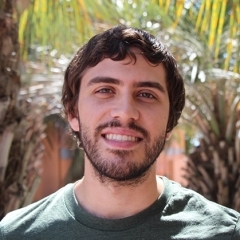
Date:
Location:
Speaker:
TITLE
Active Site Mobility Dictates Reactivity of Rh(CO)2 for Ethylene Hydroformylation
ABSTRACT
The design of heterogeneous catalysts typically emphasizes modifications of the electronic state of the active metal to control catalytic reactivity. Changes in the electronic structure of active metals often is correlated with changes in the enthalpies of adsorbed species and enthalpic reaction barriers, but inherent limitations exist on the activity and selectivity of a catalyst that can not be overcome by these modifications alone. Less often, non-covalent interactions are considered in modifying catalysts. These interactions typically limit the degrees of freedom that reactants, transition states, and products can exhibit, often resulting in modified entropies of adsorbed species and modified entropic reaction barriers. Even less commonly, the mobility of the active site is relevant to catalytic activity.
Here, we present a system in which atomically dispersed Rh/Al2O3 catalysts are modified with straight chain alkylphosphonic acid self-assembled monolayers, such that the mobility of atomically dispersed Rh is altered. Careful kinetic measurements of CO desorption from Rh(CO)2, and ethylene hydroformylation evidence that Rh(CO)2 is mobile on unmodified Rh/Al2O3, which results in entropic barriers for reactions that is lowered when the mobility of Rh(CO)2 is decreased by the phosphonic acid self-assembled monolayers. This results in improved activity and selectivity for ethylene hydroformylation with negligible changes to the enthalpic barriers. Further, the extent by which Rh(CO)2 mobility is decreased was modified by changing the length of alkylphosphonic acid tails, in which longer tailed phosphonic acids formed more rigid self-assembled monolayers due to intermolecular attractions, resulting in lower Rh(CO)2 mobility.
Despite the unique reactivity of atomically dispersed catalysts, the low active metal loadings often result in low catalyst productivity. By modifying existing synthetic protocols, changing support morphology, and using gentle and dispersive pretreatments, the Rh loading was increased by up to 80x (0.25% Rh to 20% Rh) while maintaining atomic dispersion. Additionally, phosphonic acids were used to stabilize atomically dispersed species at elevated pressures and temperatures. Overall, these studies establish the relevancy of active site mobility in atomically dispersed heterogeneous catalysts, methodologies by which to modify active site mobility, and methods to increase the loading and stability of atomically dispersed catalysts.



